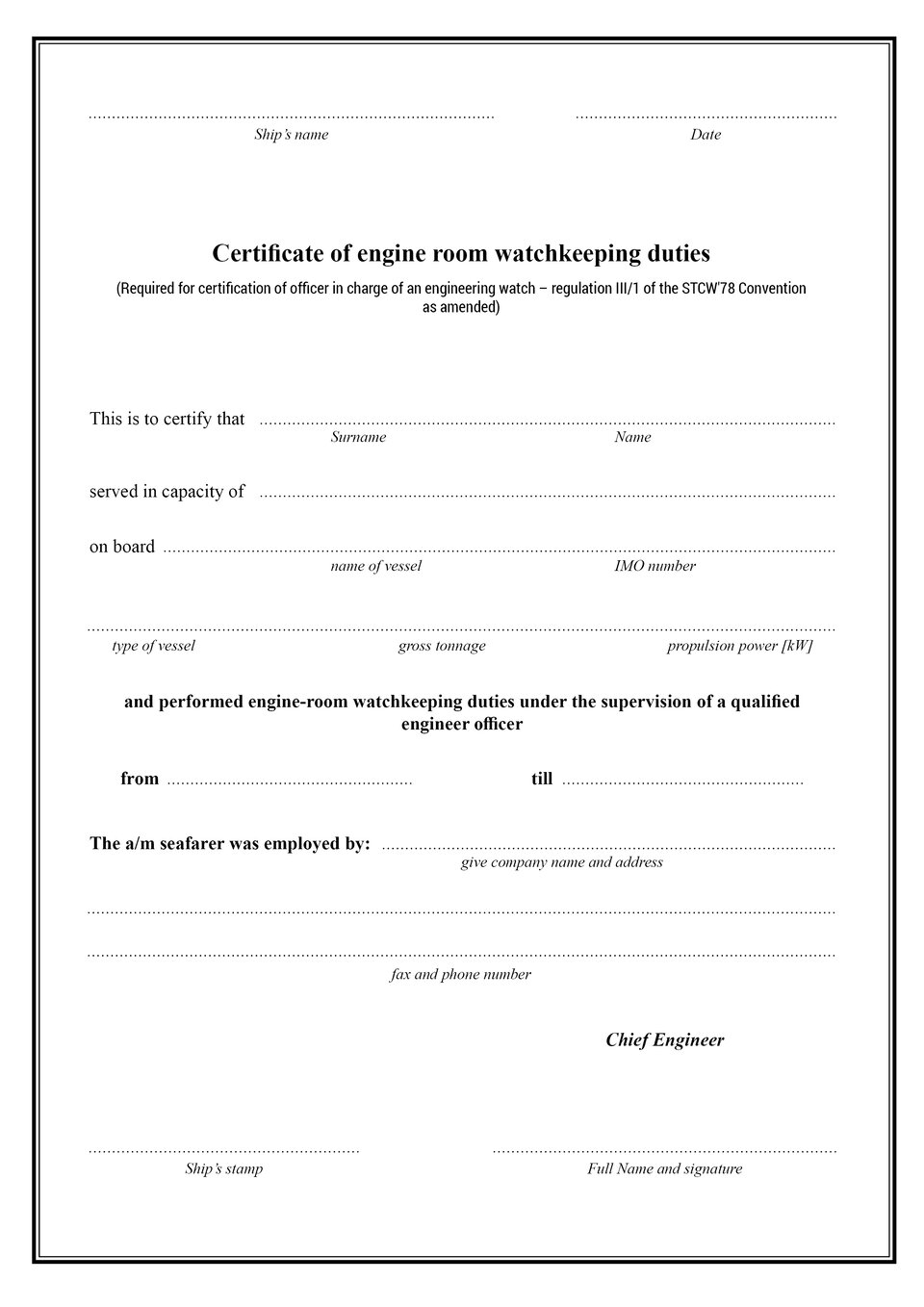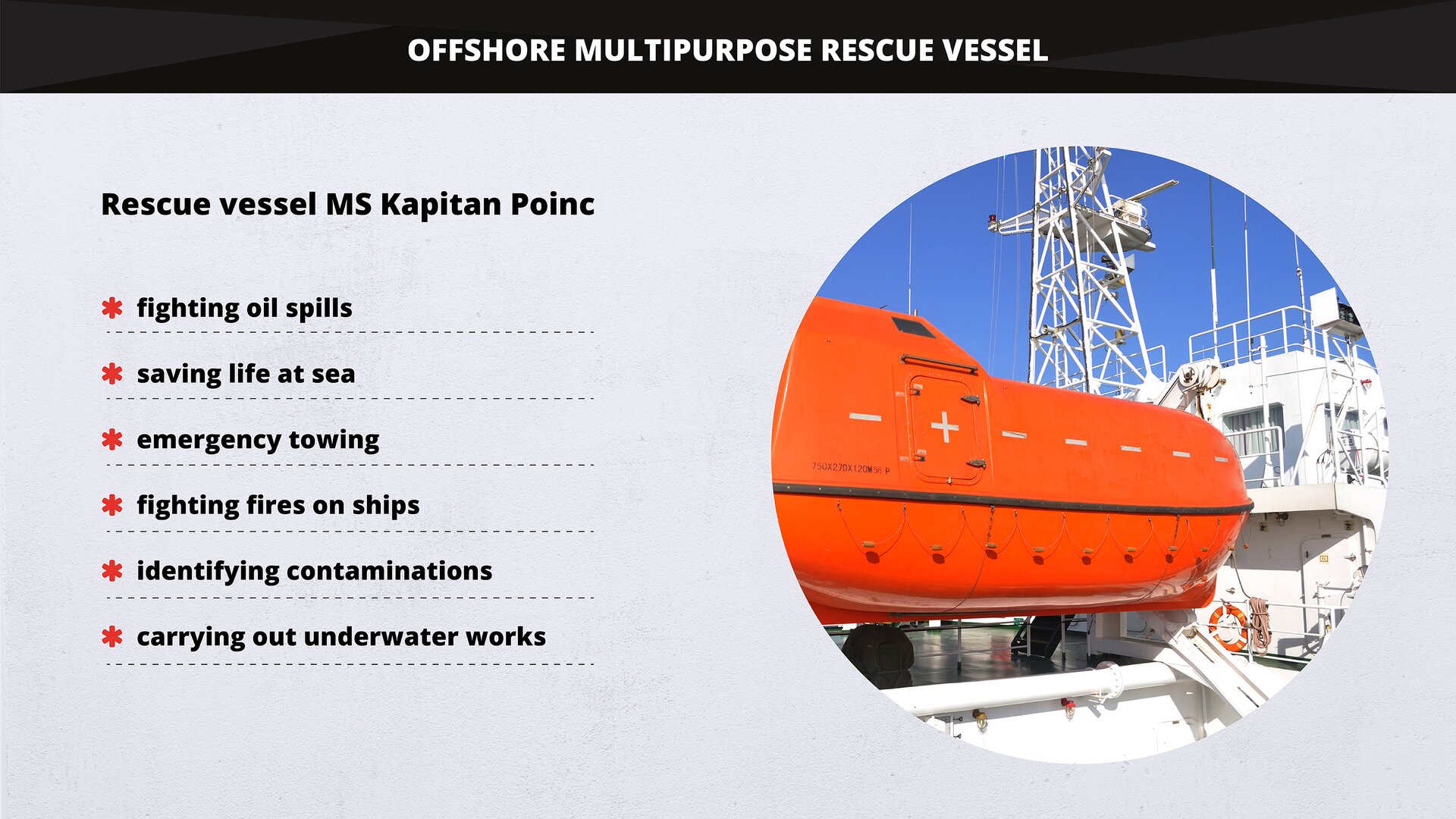E-resource SEA FISHING
Rescue at sea
1. Film in the standard version.

Film dostępny na portalu epodreczniki.pl
The video presents a conversation between two deck cadets. They prepare for an exam on a part of maritime apprenticeship on a ship. The exam will cover rescue at sea, including conducting search and rescue operations, and the use of personal and general life-saving appliances. Film przedstawia rozmowę dwóch kadetów pokładowych. Przygotowują się do zaliczenia części praktyki morskiej na statku. Zaliczenie będzie dotyczyło ratownictwa morskiego, obejmującego prowadzenie akcji poszukiwawczo-ratowniczych, oraz wykorzystanie indywidualnych i zbiorowych środków ratunkowych.
2. Film with subtitles.

Film dostępny na portalu epodreczniki.pl
The video presents a conversation between two deck cadets. They prepare for an exam on a part of maritime apprenticeship on a ship. The exam will cover rescue at sea, including conducting search and rescue operations, and the use of personal and general life-saving appliances. Film przedstawia rozmowę dwóch kadetów pokładowych. Przygotowują się do zaliczenia części praktyki morskiej na statku. Zaliczenie będzie dotyczyło ratownictwa morskiego, obejmującego prowadzenie akcji poszukiwawczo-ratowniczych, oraz wykorzystanie indywidualnych i zbiorowych środków ratunkowych.
3. Film with subtitles and pauses. Listen and repeat after the speaker.

Film dostępny na portalu epodreczniki.pl
The video presents a conversation between two deck cadets. They prepare for an exam on a part of maritime apprenticeship on a ship. The exam will cover rescue at sea, including conducting search and rescue operations, and the use of personal and general life-saving appliances. Film przedstawia rozmowę dwóch kadetów pokładowych. Przygotowują się do zaliczenia części praktyki morskiej na statku. Zaliczenie będzie dotyczyło ratownictwa morskiego, obejmującego prowadzenie akcji poszukiwawczo-ratowniczych, oraz wykorzystanie indywidualnych i zbiorowych środków ratunkowych.
4. Film with subtitles and narration.

Film dostępny na portalu epodreczniki.pl
The video presents a conversation between two deck cadets. They prepare for an exam on a part of maritime apprenticeship on a ship. The exam will cover rescue at sea, including conducting search and rescue operations, and the use of personal and general life-saving appliances. Film przedstawia rozmowę dwóch kadetów pokładowych. Przygotowują się do zaliczenia części praktyki morskiej na statku. Zaliczenie będzie dotyczyło ratownictwa morskiego, obejmującego prowadzenie akcji poszukiwawczo-ratowniczych, oraz wykorzystanie indywidualnych i zbiorowych środków ratunkowych.
On the basis of the film “Rescue at sea”, choose the correct answer. Na podstawie filmu „Ratownictwo morskie”, wybierz prawidłową odpowiedź.
general life-saving appliances, In ship documents., elements of additional life-saving systems, Mechanical and electrical life-saving appliances., a Williamson turn, depending on the situation – either a 270 degree turn, or a Williamson turn, a 270 degree turn, LSA Convention, exam, needs to study more, day off, In the maritime act., Marine Evacuation System, In the SOLAS Convention., is not prepared well, Personal and general life-saving appliances., general life-saving appliances, LSA Code, trip, personal life-saving appliances, life-saving appliances for individual use, Inland and marine life-saving appliances., is well prepared, special-purpose life-saving appliances
The decks cadets are going to have another ...............................................................................................................................................................
In which documents can we find information about life-saving equipment required on seagoing ships? ..............................................................................................................................................................
More accurate characteristics of life-saving equipment can be found in the ...............................................................................................................................................................
What are the main types of life-saving appliances on a ship? ..............................................................................................................................................................
Lifejackets, immersion suits, thermal protective aids and lifebuoys are ...............................................................................................................................................................
Life rafts, lifeboats, rescue boats are ...............................................................................................................................................................
When someone falls overboard, the ship must perform ...............................................................................................................................................................
The cadet checking the other cadets knowledge thinks he ...............................................................................................................................................................
Exercises
On the basis of the film “Rescue at sea”, fill in the gaps in the text about the signalling procedure in the event of a man falling overboard. Use the word bank.
Na podstawie filmu „Ratownictwo morskie”, uzupełnij wypowiedź dotyczącą postępowania sygnalizacyjnego w przypadku wypadnięcia człowieka za burtę. Skorzystaj z banku słów.
general alarm, MES, flag signal, Oscar signal flag, life-saving equipment, general life-saving appliances, ship’s horn, light signalling devices
Characteristics of ............................................................ can be found in the SOLAS Convention and the LSA Code.
Life jackets are not examples of .............................................................
When someone falls overboard, the ............................................................ is sounded.
It is sounded both with the alarm bell and the .............................................................
During the day, the ............................................................ is raised as well.
It is a ............................................................ that means “man overboard”.
At night, this signal is given by means of .............................................................
............................................................ is most often used on passenger ships.
Types of maritime communications

Film dostępny na portalu epodreczniki.pl
The animation presents the descriptions of basic types of maritime communications. Animacja zawiera opis podstawowych rodzajów komunikacji morskiej.
On the basis of the animation “Types of maritime communications”, decide which of the following statements are true, and which are false.
Na podstawie animacji „Rodzaje komunikacji morskiej”, zdecyduj, które z poniższych wypowiedzi są prawdziwe, a które fałszywe.
| Prawda | Fałsz | |
| Distress communications is preceded by the word MAYDAY spoken three times. | □ | □ |
| In the case of a digital selective calling (DSC), distress communications is marked as DISTRESS. | □ | □ |
| Urgency communications is preceded by the phrase URGENT URGENT repeated three times. | □ | □ |
| In the case of a digital selective calling (DSC), urgency communications is marked as URGENCY. | □ | □ |
| Safety communications is preceded by the word SECURE repeated three times. | □ | □ |
| In the case of a digital selective calling (DSC), safety communications is marked as SECURE. | □ | □ |
| Routine communications is preceded by the name of the called station repated three times. | □ | □ |
| In the case of a digital selective calling (DSC), routine communications is marked as ROUTINE. | □ | □ |
Exercises
On the basis of the animation “Types of maritime communication”, fill the gaps in the following sentences. Use the word bank.
Na podstawie animacji „Rodzaje komunikacji morskiej”, uzupełnij luki w poniższych zdaniach. Skorzystaj z banku słów.
PAN PAN, SECURITE, Global Maritime Distress and Safety System, weather forecast, DS, communications, Beaufort Scale, GMDSS
Nowadays, devices which are part of the .................................................................................... are used on ships for communication.
It is also called a .................................................................................... system.
There are four types of .................................................................................... in this system.
Digital selective calling is also called .....................................................................................
Urgency communications is preceded by the phrase .................................................................................... repeated three times.
.................................................................................... is a phrase repeated three times in the case of safety communications.
Wind strength is given in the .....................................................................................
Information about sea state, air temperature, visibility and wind is given in a .....................................................................................
Abandon ship drill
The hypertext material presents an exchange of commands between the captain and crew members during an abandon ship drill.
Hipertekst przedstawia wymianę poleceń między kapitanem a członkami załogi podczas ćwiczebnego alarmu opuszczenia statku.
Captain: After the last stop in the port, over 25% of crew memberscrew members have been replaced. That's why we have to conduct an abandon ship drill within 24 hours from the ship's departure from portdeparture from port. Officer, sound the general alarm and announce the ***abandon ship drill.******abandon ship drill.***
Senior officer [after sounding the general alarm consisting of seven or more short blasts followed by one long blast]: Attention, crew! I announce an abandon ship drill. Everyone must go to the ***assembly point.******assembly point.*** […]
Third officer [on the radiotelephone]: Captain, the crew is at the assembly point. The list was checked. All crew members are present.
Captain: Check if the crew is suitably dressed and if their lifejackets are correctly fastened.
Third officer: The crew is suitably dressed. Their lifejackets are correctly fastened.
Captain: Check if each crew member knows their duties specified in the muster listmuster list. […]
Third officer: Checked. Everyone knows their duties.
Captain: Prepare lifeboat no. 1 for lowering. […]
Third officer: Lifeboat no. 1 is ready for loweringready for lowering.
Captain: Lower lifeboat no. 1 to the water. […]
Third officer: Lifeboat no. 1 is in the water.
Captain: Check the lifeboat release mechanismrelease mechanism. Perform several maneuvers after the mechanic starts the engine.
Third officer: The release mechanism is working properly. The engine has been started. We are beginning the maneuvers.
Captain: Also check the lifeboat *m70eb0c91652b2f35_1497279767416_0
Third officer: We have finished the maneuvers. The lifeboat equipment is complete. We have begun hoistinghoisting the lifeboat aboard the ship. The lifeboat is hoisted and secured.
Captain: Thank you. I’m announcing the end of the drill. Officer, please make a record in the ship's logbook that an abandon ship drill has been conducted.
On the basis of the hypertext document “Abandon ship drill”, decide if the following statements are true, or false.
Na podstawie dokumentu hipertekstowego „Ćwiczebny alarm opuszczenia statku”, zdecyduj czy poniższe wypowiedzi są prawdziwe czy fałszywe.
| Prawda | Fałsz | |
| An abandon ship drill must be conducted because all crew members have been replaced. | □ | □ |
| The officer who sounds the abandon ship alarm is asked not to inform the crew that it is a drill. | □ | □ |
| The senior officer sounds the alarm – at least 7 short blasts and one long blast. | □ | □ |
| After checking the list, they know that all crew members are at the assembly point. | □ | □ |
| While checking the clothes and the fastening of the lifejackets by the crew, it turned out that some crew members . | □ | □ |
| Each crew member knows their duties according to the muster list. | □ | □ |
| In order to check the lifeboat release mechanism, several manoeuvres should be performed after starting the engine. | □ | □ |
| The officer is asked to make a record in the ship's logbook that an abandon ship drill has been conducted. | □ | □ |
Distress communications

Film dostępny na portalu epodreczniki.pl
The cruise ferry “Estonia” makes a distress call to the “Tallinn Radio” coast station and other ships. Prom o nazwie ‘’Estonia’’ prowadzi łączność w niebezpieczeństwie ze stacją brzegową ‘’Tallin Radio’’ oraz innymi statkami.
On the basis of the audio recording “Distress communications”, choose the correct answers.
Na podstawie nagrania audio „Wymiana łączności w bezpieczeństwie”, wybierz poprawne odpowiedzi.
ship, a lot of people on board, dangerous goods on board, safety communications, coast radio, cruise ferry, too close to the shoreline, routine communications, deck, coast radio, an MMSI number, Estonia’s latitude, distress communications, captain's bridge, the name of the cruise ferry, on land, cruise ferry, in distress, a damaged engine room, Estonia’s position, bow door, Estonia’s MMSI number, ship, a call sign
Estonia is the name of a .........................................................
Tallinn Radio is the name of a .........................................................
Estonia is .........................................................
The cruise ferry reports damage to the .........................................................
Sierra Papa Bravo Lima is .........................................................
The audio recording presents an example of .........................................................
Estonia has .........................................................
278361234 is .........................................................
Exercises
On the basis of the audio recording “Distress communications”, fill the gaps in the following sentences. Use the word bank.
Na podstawie nagrania audio „Wymiana łączności w bezpieczeństwie”, uzupełnij luki w zdaniach. Skorzystaj z banku słów.
side, dangerous goods, longitude, latitude, true course, Radio Tallinn, position, time of arrival
The cruise ferry gives her .............................. at 0122 hours Universal Time.
.............................. five nine degrees two three minutes north latitude.
.............................. zero two one degrees four two minutes east longitude.
The cruise ferry has a dangerous list to the right ...............................
The cruise ferry does not have .............................. on the side.
The present .............................. of the cruise ferry is 270 degrees, the speed is 7 knots.
.............................. is sending rescue units.
The estimated .............................. of the rescue units is 03:00.
On the basis of the audio recording “Distress communications”, match the following words/phrases with their translations.
Na podstawie nagrania audio „Wymiana łączności w bezpieczeństwie”, połącz poniższe terminy z ich tłumaczeniami.
latitude, longitude, bow door, true course, dangerous goods, call sign, knot, side, position, list
| sygnał wywoławczy | |
| pozycja | |
| szerokość geograficzna | |
| długość geograficzna | |
| furta dziobowa | |
| przechył | |
| burta | |
| ładunek niebezpieczny | |
| kurs rzeczywisty | |
| węzeł |
Engine room watchkeeping

Gallery
Part of speech and Type a word

Zasób interaktywny dostępny pod adresem https://zpe.gov.pl/a/D8tqL8he1

Zasób interaktywny dostępny pod adresem https://zpe.gov.pl/a/D8tqL8he1
Dictionary
zwrot o 270°
ćwiczebny alarm opuszczenia statku
temperatura powietrza
dzwonek alarmowy
miejsce zbiórki
furta dziobowa
sygnał wywoławczy
skażenie
kontrkurs
stan załogi
ładunek niebezpieczny
wyjść z portu
łączność alarmowa
holowanie ratownicze
wachta maszynowa
wyposażenie
wypaść za burtę
sygnał flagowy
alarm ogólny
zbiorowy środek ratunkowy
pojemność brutto
ster
wciąganie
kombinezon ratunkowy
pełnić wachtę
węzeł
szerokość geograficzna
łódź ratunkowa
koło ratunkowe
tratwa ratunkowa
pas ratunkowy
sprzęt ratunkowy
środek sygnalizacji świetlnej
przechył
długość geograficzna
Kodeks LSA
Morski System Ewakuacji MES
rozkład alarmowy
nazwa statku
oficer mechanika wachtowego
zanieczyszczenie olejowe
kurs początkowy
tor śladowy
flaga MKS Oscar
burta przeciwna
statek pasażerski
indywidualny środek ratunkowy
pozycja
moc maszyny
gotowa do opuszczenia
kurs przeciwny
system zwalniający
łódź ratownicza
statek ratowniczy
łączność rutynowa
łączność bezpieczeństwa
stan morza
marynarz
statek morski
syrena okrętowa
dziennik okrętowy
burta
sygnały
konwencja SOLAS
pieczątka
manewr zatrzymania statku
środek ochrony cieplnej
kurs rzeczywisty
typ statku
praca podwodna
łącznośc pilna
widzialność
pętla Williamsona


